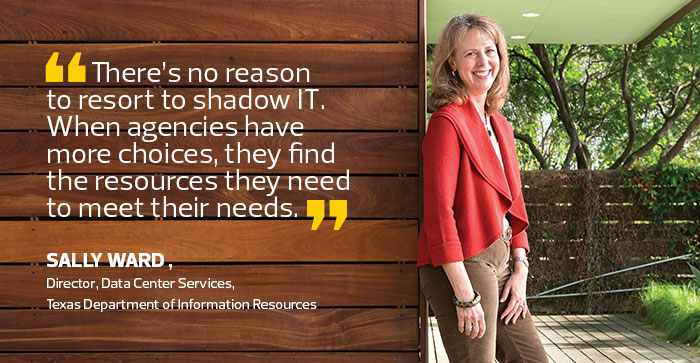Local Governments Take Cloud to the Next Level
Appropriately enough, the state of Texas thinks big when it comes to hybrid clouds.
Rather than just taking advantage of typical hybrid features like cloud bursting, the Department of Information Resources (DIR) uses this cloud model to provide an innovative IT services marketplace that may be a first for state government, Data Center Services Director Sally Ward says.
The marketplace allows state agencies to provision server and storage capacity. After plugging in their requirements, the marketplace shows three choices — one for the state’s private cloud, the others for prevailing contracts for public cloud vendors. The costs and available features, including security capabilities, also appear.
“We’re driving self-service for our customers so they don’t have to pick up the telephone and call the service desk whenever they need new capacity,” she says.
Launched just this year, early results indicate success: “We’re seeing agencies starting to consolidate small websites that had popped up in their departments,” Ward says. “There’s no reason to resort to shadow IT. When agencies have more choices, they find the resources they need to meet their needs.” Texas’s marketplace illustrates how some state and local IT departments have not only embraced the cloud, but assist other agencies to shape and leverage it in new and creative ways.
Private and Public Clouds Team to Offer the Best of Both Worlds
“We may be approaching a time when government organizations re-evaluate how they’re using the cloud,” says Charles King, principal analyst at market research firm Pund-IT.
Building on past cloud deployments that helped control costs and reduce data center complexity, pioneering state and local IT organizations are part of a maturation of the public cloud ecosystem and market, he says. In turn, cloud could speed the adoption of new innovations.
“The Internet of Things (IoT), advanced analytics and other efforts require substantial investments and considerable in-house IT skills,” King says. “That could make related services from cloud providers extremely attractive.”

Photography by John Davidson.
Since 2005, the Texas DIR has steadily consolidated and modernized its IT infrastructure. Today, nearly 75 percent of the state’s IT assets run in two data centers that rely heavily on virtualization technology from Cisco Systems, VMware, Oracle and IBM. Thirty state agencies share the private community cloud created by the two data centers. It’s so efficient that virtual servers, complete with all necessary security provisions, become available within hours of an agency’s request, Ward says.
To create the IT marketplace, DIR extended the private cloud with the two public cloud options, offering agencies new choices for matching workloads with the appropriate services. For example, public cloud services are attractive for testing and development projects, such as sandboxing application and security updates prior to releasing them to production.
“Agencies can spin servers up or down and pay only for what they need,” says Brad Helbig, chief technical architect at the Texas DIR.
In turn, the private cloud excels for large enterprise applications that require high performance and low latency, such as enterprise resource planning platforms, he says. He sees the marketplace’s on-demand services growing in importance by furthering Agile and DevOps development projects. But first, IT leaders must overcome early challenges, including slow adoption of IT self-provisioning by some agencies. Ward encourages those groups to choose a small pilot project and allow DIR enterprise architects to walk them through the online provisioning process.
“Their adoption rates will become much higher as they experience the speed and financial benefits,” she says.
Detroit's Cloud Offers More Accessible E-Commerce
In the Detroit suburb of Oakland County, Mich., officials tapped private and public clouds to create their own marketplaces, but rather than provisioning servers, those resources reduced the cost and complexity of online payment systems and software procurements.
The county’s G2G Cloud offers e-commerce technology for cities and towns via a private cloud, which is now being replicated to a third-party vendor. More than 60 municipalities within the county, and a similar number in other parts of the state, take advantage of the service, says Phil Bertolini, the county’s CIO.
“E-commerce is difficult for local government to implement because of PCI and other regulations,” he says. “So we provide everything they need for their citizens — shopping carts, the payment engine and the supporting infrastructure.”
The G2G Cloud processes $21 million in transactions per year, and a percentage of a transaction fee paid by citizens covers the county’s ongoing development, maintenance and support expenses. More recently, the county launched the G2G Marketplace, a cloud that helps municipalities procure software and services from county contracts. Products include several network and cloud-based security solutions, VMware vCloud services and a central workforce management suite.
“Municipalities love it. It speeds procurements and they pay a lower price because the county can negotiate better terms since it’s a large entity,” Bertolini says.
Of course, volume pricing has ripple effects: “Because of the additional business, many vendors agree to reduce what the county would otherwise pay for the contracts,” he says.
Indiana's Private Cloud Lays a Foundation for the Future
The state of Indiana’s private community cloud significantly cut IT expenses and has encouraged the IT department to deepen its commitment to the cloud. “For new proposals, we consider the cloud first, then we determine if there are any unique reasons why the cloud wouldn’t make sense,” says Jim Rose, the state’s chief technology officer.
The private cloud uses VMware virtualization technology and runs about 75 percent of the state’s servers. Agencies no longer invest in their own hardware and software for web servers and other IT resources, but instead pay a set monthly service fee based on use. That has helped to shutter several data centers, and save the state about $14 million annually, Rose says. Those savings are important, but they’re not the only benefit. Having a mature cloud strategy in place is essential for future IT success, Rose says.









